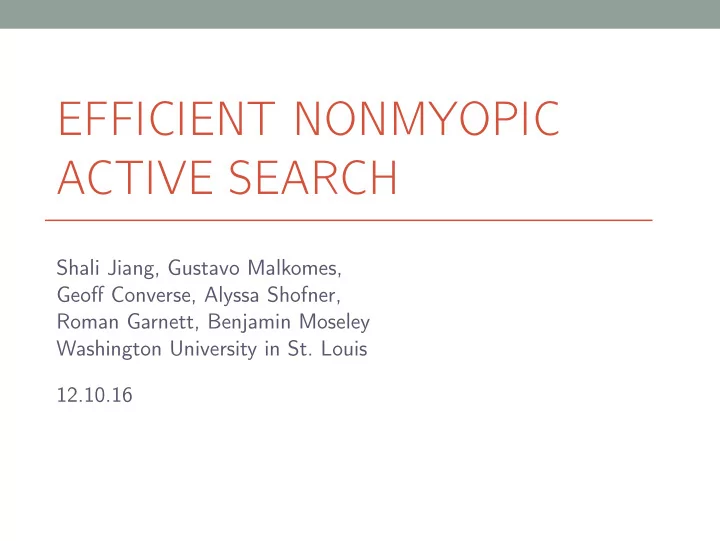

EFFICIENT NONMYOPIC ACTIVE SEARCH Shali Jiang, Gustavo Malkomes, Geoff Converse, Alyssa Shofner, Roman Garnett, Benjamin Moseley Washington University in St. Louis 12.10.16
1. ACTIVE SEARCH Finding interesting points
Active search 1 • In active search , we consider active learning with an unusual goal: locating as many members of a particular class as possible. • Numerous real-world examples: • drug discovery, • intelligence analysis, • product recommendation, • playing Battleship. 1 Garnett, Krishnamurthy, Xiong, Schneider (CMU), Mann (Uppsala). ICML 2012. Active Search Active Search 3
Battleship! Active Search Active Search 4
Another definition Active search is Bayesian optimization with binary rewards and cumulative regret. Active Search Active Search 5
Our approach We approach this problem via Bayesian decision theory. • We define a natural utility function, and • The location of the next evaluation will be chosen by maximizing the expected utility. Active Search Active Search 6
The utility function (cumulative reward) The natural utility function for this problem is the number of interesting points found. Active Search Expected utility 7
The Bayesian optimal policy The optimal policy may be derived by sequentially maximizing the expected utility of the final dataset. With a budget of B , at time t , we select � � arg max u ( D B ) | x t , D t − 1 E x t = arg max [expected utility starting from point x t ] . x t Active Search Expected utility 8
The Bayesian optimal policy This may be written recursively: [expected utility starting from point] = [current utility] + [expected utility of point] + � �� � exploitation, < 1 � � [success of remaining search] E y t . � �� � exploration, < B − t Automatic dynamic tradeoff between exploration and exploitation! Active Search Expected utility 9
Lookahead • Unfortunately, the computational cost of computing the optimal policy is expensive. (Exponential in the number of points!) • In practice, we use a myopic approximation, where we effectively pretend there is only a small number of observations remaining. Active Search Expected utility 10
The Bayesian optimal policy [expected utility starting from point] = [current utility] + [expected utility of point] + � �� � exploitation, < 1 � � E y t [success of remaining search] . � �� � exploration, < B − t Active Search Expected utility 11
ℓ -step myopic approximation [expected utility of next few points] = [current utility] + [expected utility of point] + � �� � exploitation, < 1 � � [success of next few points] E y t . � �� � exploration, < ℓ ( ℓ is normally 2–3). Active Search Expected utility 12
Problems • The dependence on the budget has been lost! • Exploration is heavily undervalued! Active Search Expected utility 13
Lookahead can always help Theorem (Garnett, et al.) Let ℓ, m ∈ N + , ℓ < m . For any q > 0 , there exists a search problem P such that � � E D u ( D ) | m, P � > q ; � u ( D ) | ℓ, P E D that is, the m -step active-search policy can outperform the ℓ -step policy by any arbitrary degree. Active Search Expected utility 14
Our idea: Efficient nonmyopic active search • Our idea is to approximate the remainder of the search differently. We assume that any remaining budget is selected simultaneously in one big batch. • Similar idea to the GLASSES algorithm, in a different context (and in this case, exact and efficient ). • Exploration encouraged correctly! Automatic, dynamic tradeoff restored! Active Search Expected utility 15
2. QUICK EXPERIMENT
CiteSeer data • Includes papers from the 50 most popular venues present in the CiteSeer database. • 42k nodes, 222k edges. • We search for NIPS papers, 2.5k papers (6%). ← − − − − − − → cites/cited by paper A paper B Results 17
Experiment • We select a single NIPS paper at random, and begin with that single positive observation. • The one- and two-step myopic approximations were compared with our method ( ENS ). Results 18
Results 200 1-step 2-step ENS number of targets found 150 100 50 0 0 100 200 300 400 500 number of queries Results 19
Results: Zoom 20 1-step 2-step ENS number of targets found 15 10 5 0 0 20 40 60 number of queries Results 20
Results: Budget query number policy 100 300 500 700 900 one-step 25.5 80.5 141 209 273 two-step 24.9 89.8 155 220 287 ENS –900 25.9 94.3 163 239 308 ENS –700 28.0 105 188 259 ENS –500 28.7 112 189 ENS –300 26.4 105 ENS –100 30.7 Results 21
2. THANK YOU! Questions?
Recommend
More recommend